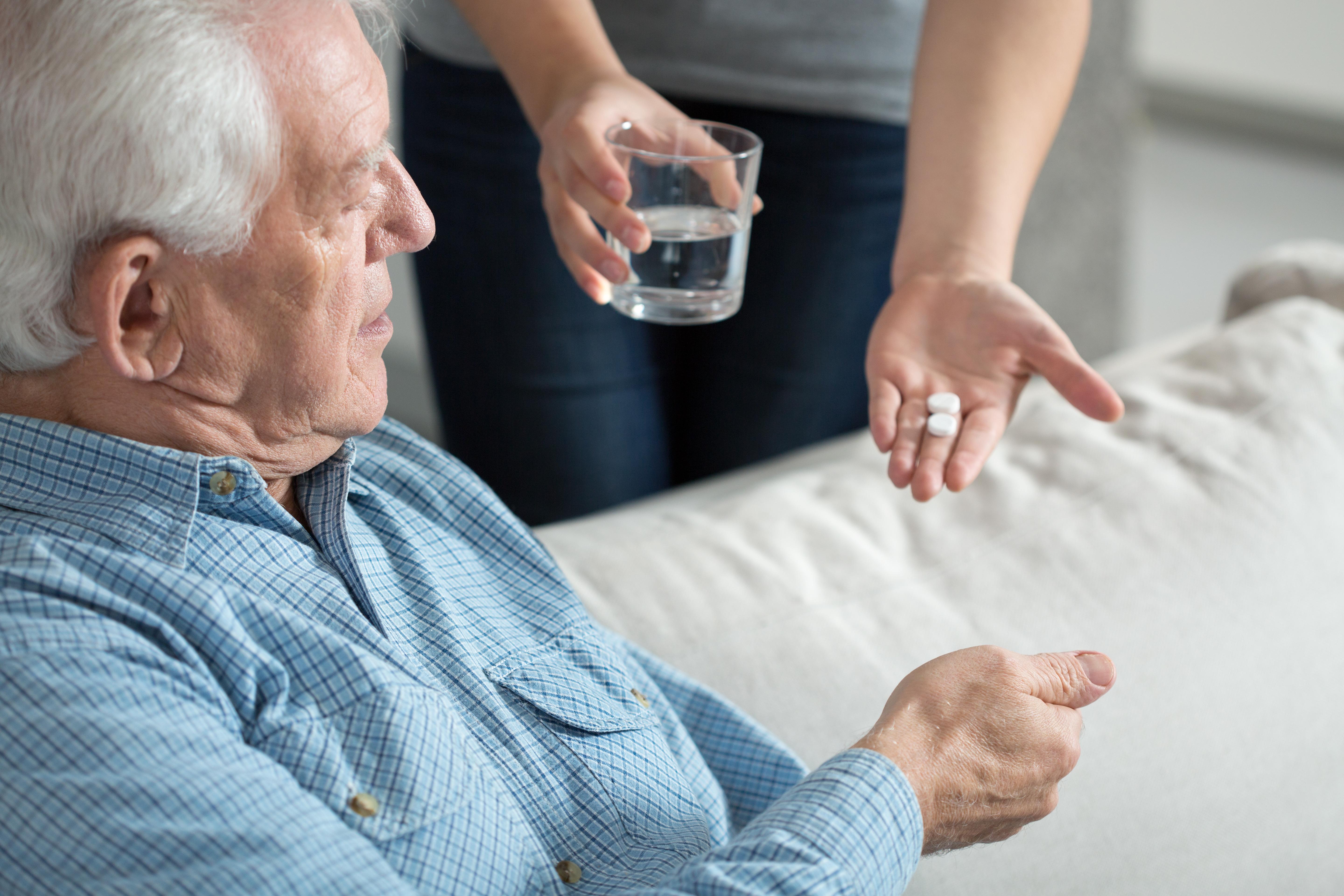PD and Medication: Advancing Treatment

The second most common neurodegenerative disorder after Alzheimer’s disease, Parkinson’s disease (PD) affects approximately one million Americans. Scientists are working toward discoveries to prevent or slow the disease early on, before it affects movement. Breakthrough studies include genetic research that could lead to targeted PD therapy. In the meantime, experts are finding ways to boost the effectiveness of existing medications, and introducing new motor and non-motor symptom treatments nearly every year.
This article is based on a Parkinson’s Foundation Expert Briefings webinar exploring innovative PD treatments by Fernando Pagan, MD, Georgetown University Hospital Medical Director, a Parkinson’s Foundation Center of Excellence.
Simply put, medication can help people better manage Parkinson’s symptoms. Before carbidopa/levodopa (brand name SINEMET®) ― long successful in lessening motor symptoms ― was introduced in the 1960s, the lifespan of people with PD was well below that of the general population. After its discovery, people with PD’s life expectancy equaled that of the general population. Studies show treating Parkinson's improves life for those living with PD ― increasing lifespan and reducing symptoms.
An Introduction to PD Medication
Not too long ago, medication options were limited; doctors often postponed treatment to delay medication-associated side effects. Today more than 30 medication options are available. Working with your doctor to try to find the right medicine combination for you is key.
Those with mild PD symptoms may wonder when beginning treatment makes sense. Research shows earlier detection, treatment and expert care helps people with Parkinson’s live well longer.
Many Parkinson’s symptoms are due to lack of dopamine in the brain. Dopaminergic medications include levodopa and dopamine agonists. These either briefly replenish dopamine or mimic its action. Other neurotransmitters are also involved in PD, including acetylcholine, serotonin and norepinephrine. Newer treatments to modulate these can improve different PD symptoms.
Carbidopa/levodopa formulations
Levodopa, the most effective PD treatment, converts to dopamine in the brain. Carbidopa enhances levodopa ― preventing nausea and helping more levodopa get to the brain, so less medication is needed.
Drug manufacturers prepare Levodopa differently ― including a variety of strengths, immediate or controlled-release and liquid form. Some preparations are designed to address specific challenges, such as Parkinson’s-related gastrointestinal (GI) issues, which can interfere with medication absorption.
- Immediate and controlled-release carbidopa/levodopa tablets can be used alone or in combination with other medications to improve slowness, stiffness and tremor in Parkinson’s.
- Long-acting extended release carbidopa/levodopa, IPX066/Rytary, contains beads designed to dissolve at different rates, giving users longer lasting benefits.
- Carbidopa/levodopa enteral suspension – (CLES or DUOPA™) – is delivered into the small intestine improving absorption and reducing “off” times.
- Levodopa inhalation powder INBRIJA™ is an add-on drug for “off” periods in people taking carbidopa/levodopa. Administered via inhaler, it bypasses the GI system. It can be used up to five times a day, improving “off” symptoms for people with decreased gut motility while waiting for oral carbidopa/levodopa to take effect.
Dopamine agonists
These medications come in a variety of formulations to supplement or boost the action of levodopa. Compulsive behaviors can be a side effect.
- Dopamine agonist rotigotine transdermal patch (NEUPRO®) delivers medication through the skin, directly into the bloodstream.
- One of the oldest and most potent on-demand dopamine agonists, apomorphine, is administered via injection, delivering “on” time within about 10 minutes. Still in clinical trials is sublingual apomorphine. Dissolved under the tongue, it can relieve “wearing off” episodes for people with Parkinson’s disease in 15 minutes.
- Currently only available in Europe, subcutaneous apomorphine treatment offers a less invasive motor fluctuation treatment option. A small delivery tube placed under the skin is connected to an apomorphine-filled pumping device. It can reduce daily “off” time and possibly dyskinesia by reducing needed levodopa dose. Those with hallucinations and dementia might not be candidates.
COMT inhibitors
COMT (catechol-o-methyl transferase) inhibitors, used with levodopa, ease “wearing off” symptoms and extend “on” time by blocking levodopa breakdown. The three COMT categories include:
- tolcapone
- entacapone (some formulations combine levodopa/carbidopa/entacapone)
- opicapone, currently only available in Europe
MAO-B inhibitors
MAO-B (monoamine oxidase type B) inhibitors also block dopamine breakdown, and can be used as monotherapy in early Parkinson’s. As PD progresses, it may be used as an add-on to other medications. Forms include:
- selegiline
- rasagiline
- safinamide
Anticholinergics
Anticholinergics reduce tremor by blocking overactivity of acetylcholine, a neurotransmitter regulating movement. Younger patients often better tolerate these treatments due to potential side effects, including dry mouth, constipation and hallucinations. Types include benztropine and trihexyphenidyl HCL.
Amantadine
An early Parkinson’s drug, amantadine was originally developed as an antiviral agent. It was found to also improve PD tremor, rigidity and dyskinesia. Delivery is improved in new, long-acting forms of this drug. GOCOVRI® ER amantadine capsules treat dyskinesia and “off” time in people with PD taking carbidopa/levodopa. This must be taken before bedtime and provides control of dyskinesia upon awakening and throughout the day.

A2A antagonist
A brain circuit group called the basal ganglia play a role in PD symptoms. The basal ganglia have adenosine A2A receptors that are located next to dopamine receptors. Scientists have found activating the dopamine receptor or blocking the adenosine A2A receptor can improve PD symptoms.
Istradefylline, an adenosine A2A receptor antagonist improves motor symptom fluctuations. It received U.S. FDA approval in 2019.
Managing Non-motor Symptoms
Non-motor symptoms are common in Parkinson’s and can be more challenging than motor symptoms. There are many management medications available.
Orthostatic hypotension
About one-third of people living with PD experience a significant blood pressure drop upon standing, known as orthostatic hypotension; certain medications can worsen this. This drop can cause lightheadedness or fainting, and other symptoms.
Droxidopa (NORTHERA®) treats lightheadedness. It should not be taken within five hours of bedtime. Side effects include headache, dizziness, nausea, fatigue and high blood pressure when lying down.
Psychosis
Confusion, hallucinations and delusions can be experienced by up to 70 percent of people living with Parkinson’s. The disease itself or PD medications can cause PD-associated psychosis.
The newest treatment, pimavanserin (NUPLAZID®), does not block dopamine or worsen motor symptoms. It can improve hallucinations, delusions, night-time sleep and daytime sleepiness. Side effects include nausea, confusion and hallucinations. Older options have treatment shortcomings.
Clozapine (Clozaril) requires weekly blood tests, and though quetiapine prescribed off-label hasn’t been shown effective across several randomized Parkinson’s disease clinical trials many Parkinson experts believe it is helpful for hallucinations.
Drooling
The FDA recently approved the botulinum toxins XEOMIN® (incobotulinumtoxinA) and MYOBLOC® (rimabotulinumtoxinB) to treat sialorrhea, or drooling, a common Parkinson’s symptom. MYOBLOC is also be used to treat PD-related sustained cramping, or dystonia.
Rivastigamine
The rivastigmine (Exelon®) patch, a treatment for Alzheimer’s, can improve mild cognitive impairment or dementia in Parkinson’s. Donezepil (Aricept) can also be used.
Sleep disorders
PD-related brain changes can cause sleep challenges. People with rapid eye movement sleep behavior disorder (RBD) do not have normal muscle relaxation while dreaming, causing them to act out dreams during REM sleep. Clonazepam and melatonin can be used to improve symptoms.
Surgical Interventions
This multi-procedure surgery inserts electrodes into a motor-function targeted brain area; an implanted impulse generator battery then stimulates this area with electrical impulse to improve “on” time. Users are given a DBS control device. Manufactures Abbott, Boston Scientific and Medtronic have all made recent improvements to these devices.
More Resources
Check out more Parkinson’s Foundation resources about medication now:
- Medications: A Treatment Guide to Parkinson's Disease
- Prescription Medications
- Worksheet: Medications and Schedule
- Podcast Episode 75: Pharmacy Challenges with PD
If you have any questions about Parkinson’s medications call our Helpline at 1-800-4PD-INFO (473-4636).
Related Blog Posts

Neuro Talk: Newly Diagnosed

Meet a Researcher Working to Make Adaptive DBS More Effective
